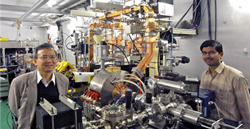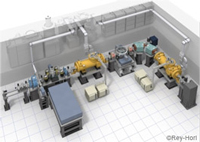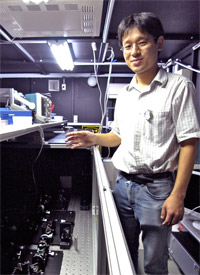 |
 |
|||||||||||||
|
|||||||||||||
|
|||||||||||||
|
The Quantum Beam Project, a year–old project to study and utilise the quantum nature of particle beams at KEK, is developing a commercial version of a new affordable, compact X–ray source. The aim of the project is to develop a compact and high–quality particle source for broad commercial use in medicine, life science, information technology, nanotechnology, and quantum science. The project's name, Quantum Beam, refers to beams of particles like neutrons, photons, and ions, which exhibit quantum mechanical behaviours, and the unique feature of the project is to take advantage of this nature to promote the technology transfer of an affordable compact X–ray source to hospitals and research institutions. This project is a collaboration of around 50 scientists from 18 companies, universities, and research institutions across Japan. Led by Junji Urakawa, former spokesperson for Accelerator Test Facility at KEK, the team is now working on research and development of a next–generation compact X–ray source based on a superconducting electron accelerator and high–quality laser cavity. The superconducting cavity accelerates electrons to 25 million electronvolts (MeV). These electrons hit a tightly focused laser beam and produce X–rays at 0.2–70 kiloelectronvolts by inverse Compton scattering. The device has several different components: an electron gun to fire electrons, superconducting cavities to accelerate and decelerate electrons, a refrigerator to cool the cavities, a laser cavity to store the intense laser beam, and a beam dump. Expected to be no more than 10 metres in length, the entire station will fit in an average hospital or laboratory room. “This will be the first application of superconducting radiofrequency cavities to a commercial product,” says Urakawa. “Our goal is to make the station compact, and for that superconducting cavities play a significant role.” The Quantum Beam team closely collaborates with the KEK–based team of the International Linear Collider for cavity development. The ILC aims at a cavity gradient of more than 35 megavolts per metre. “For the performance we seek, we need 30 megavolts per metre, which we've already achieved.” Just a one–metre superconducting cavity will be sufficient to accelerate electrons to the necessary energy.
Current inverse Compton X–ray sources produce up to 109 electrons per second at higher performance X–ray sources such as Helios by Oxford Instruments. The new device is aiming for higher intensity of 1010 photons per second. The key to such high intensity is to make the waist size of the beam at the collision point as small as possible, as well as to superpose the pulses as many times as possible. To achieve this, the laser team is developing a four–mirror system, which produces a circularly polarised laser beam from the linearly polarised beams of the injected laser. “With the four–mirror cavity, we can make the beam much more intense than when we use two–mirror system,” explains Kazuyuki Sakaue of Waseda University, who developed the four–mirror laser cavities together with scientists from KEK and Linear Accelerator Laboratory (LAL) in France. The team uses a non–planar configuration for the two concave and two flat mirrors, arranging them in a three–dimensional twisted configuration. This makes the beam's image rotate as it travels the optical path, making the laser circularly polarised. With the new technology, scientists will be able to change the polarity up to 1000 times per second, ten times more than possible polarity with current technologies using undulators. It may bring about a revolution in the way we understand biological systems by helping to explain the broken symmetries in biochemistry. Yosuke Honda, a member of the KEK laser team, discovered this novel property in a rather unexpected way. Last summer, Honda was working with the four–mirror cavity, and saw a peculiar two–peak signal on the oscilloscope that appeared as he changed the position of a concave mirror. Honda and his team found that each of the two peaks corresponded to a circularly polarised beam. They also made a calculation for the system, and successfully explained the experimental data. The ingenuity of their new idea made it possible to utilise this feature for obtaining a stable differential signal to control the beam. The team is now working to increase the enhancement factor (the number of pulses that are stored in the cavity), as well as to improve the focus of the laser beam. “I had been doing fundamental sciences, which I'm afraid had not yet resulted in anything useful to society,” Urakawa said. Less than one year into this new project, the team has already started to transfer the technology to universities and companies in Japan. “The result will come out soon. We are also planning to share this technology with Indian institutions.” Urakawa says that he would like to see the project through to completion, and witness the affordable, compact X–ray machine installed in hospitals to aid in medical treatment. His three key goals are "safe, useful, and for society." -- Misato Hayashida
Related site:
|
|||||||||||||
| © International Linear Collider |


